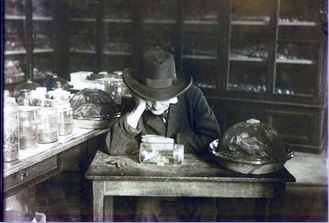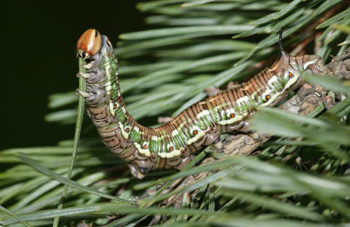Welcome to the Amazing World of the Insects
Life of Jean-Henri Casimir Fabre
 Born in French town Saint-Leons in Aveyron in a poor family, Fabre started
his career at the age of 19 as a teacher. Students of the college of Ajaccio,
Corsica were lucky to have him teaching there. Since 1852 students of Avignon
lyceum had also welcomed Fabre in their alma mater and were captivated by his
marvelous teaching ability. Yet, Fabre's vivid mind and extraordinary passion
to science didn't let him to stop at that point. During his long and fruitful
life Jean-Henri Fabre tried himself as a physicist, chemist and botanist.
Born in French town Saint-Leons in Aveyron in a poor family, Fabre started
his career at the age of 19 as a teacher. Students of the college of Ajaccio,
Corsica were lucky to have him teaching there. Since 1852 students of Avignon
lyceum had also welcomed Fabre in their alma mater and were captivated by his
marvelous teaching ability. Yet, Fabre's vivid mind and extraordinary passion
to science didn't let him to stop at that point. During his long and fruitful
life Jean-Henri Fabre tried himself as a physicist, chemist and botanist.
Despite Fabre's passion to many sciences, his most famous achievements lie in the sphere of entomology. This science studying the life and the habits of insects became his greatest passion and until his death Jean-Henri Fabre kept observing and making notes about these amazing tiny creatures inhabiting any piece of nature, including scientist's own backyard.
Read more about Jean-Henri Fabre's life
Works of Jean-Henri Casimir Fabre
 Most entomologists now
agree that Jean-Henri Fabre's role in popularization of this science about
insects can not be overestimated. The ten volumes of Souvenirs
Entomoligiques which took almost 30 years to complete are the great
heritage that prominent scientist has left us. Even though the scientist wrote
numerous books, articles and letters devoted to entomology, yet these ten
volumes have become the true gem of entomological science and naturalistic
encyclopedia as well. Written in humanistic style and from the first person
Fabre's observations and experiments are so easy and fascinating to read that
entomology had finally become popular among nature-lovers without a science
degree.
Most entomologists now
agree that Jean-Henri Fabre's role in popularization of this science about
insects can not be overestimated. The ten volumes of Souvenirs
Entomoligiques which took almost 30 years to complete are the great
heritage that prominent scientist has left us. Even though the scientist wrote
numerous books, articles and letters devoted to entomology, yet these ten
volumes have become the true gem of entomological science and naturalistic
encyclopedia as well. Written in humanistic style and from the first person
Fabre's observations and experiments are so easy and fascinating to read that
entomology had finally become popular among nature-lovers without a science
degree.
Unfortunatelly, Fabre was not discovered soon. Only after the last volume of Souvenirs Entomoligiques had been published, the public has finally appreciated the tremendous work of the scientist. Jean-Henri Fabre was invited to numerous scientific societies, was recognized by colleagues as a serious entomologist, and even the president of France has personally visited him and granted a government pension. By that time Fabre was 85 years old.
Fabre's colleague Charles Darwin has called him „an inimitable observer“ and was definitely right. The special achievement of Fabre's works is that they are based on observations of insects in the natural area of inhabitation, while other entomologists of that time preferred to base their conclusions on the studies of a dead insects. In the age of 55 Fabre has bought a piece of land in „Harmas de Serignan“ in Provence, which later became the main arena of his studies and observations. This land now serves a museum devoted to the life and works of Jean-Henri Fabre.
Once Fabre studied the habits and instincts of pine processionary caterpillars and he manipulated them to form a loop around a pot and they moved around following this circular pattern for seven days in a row. Observations similar to this one and a lot more of fascinating entomological studies are described in Fabre's „memoirs“.
Read the full versions of Fabre's works
Medicine

You will be amazed by the numerous ways that insects are used for medical purposes. For example, ants were used in ancient India to close wounds by placing an insect's jaws in front of the opposite ends of a wound. The ant would bite and then its thorax and abdomen was pinched off.
„Wound Myiasis“ were commonly used during Civil War as a healing anticepsis agents. The dipterous larva was placed in the bad wounds and were allowed to remian there until all dead tissues were eaten away. The wound would then heal fast and the process of decay would be stopped. The larvae would not only remove the ded tissues, but would also secrete an antibiotic.
Blister beetles or Spanish flies are used as a source of cantharidin, a blistering agent. Hippocrates has tried using cantharadin to cure edema, rheumatism and even for the treatment of baldness.
Bees and wasps produce venom, which is used in medicine and cosmetology for numerous purposes.
Nature
 Entomolgy
is one of the most amazing sciences that lets us take a glance at the wonders of
nature. Butterflies, caterpillars, mantis, bees, beetles and grasshoppers
– all these tiny insects are so amusing to observe and so surprisingly
complex in their behavior to understand! They are all part of the big and whole
circle of life called nature.
Entomolgy
is one of the most amazing sciences that lets us take a glance at the wonders of
nature. Butterflies, caterpillars, mantis, bees, beetles and grasshoppers
– all these tiny insects are so amusing to observe and so surprisingly
complex in their behavior to understand! They are all part of the big and whole
circle of life called nature.
Wherever you go – step on the porch of your own house, go to a village, resort or a seaside, travel in the desert or enjoy the views of the mountains – nature is always with you. We are the part of it and we use it as well for recreation and treatment, relaxation and rest, inspiration and encouragement. Why not learn more about this greatest wonder of life?









